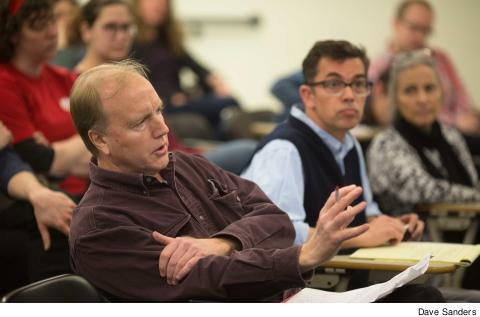Labor law amended to help public unions
 |
Four percent? Is it that simple?
That’s the nominal increase in funding for CUNY senior colleges under the state budget finalized at the end of March. The increase of $97 million – bringing the total state funding to these colleges to $2.53 billion – includes $43.5 million to fund employee fringe benefit cost increases, $31.3 million in tuition assistance to accommodate a $200 increase in tuition and $4.7 million for CUNY’s Search for Education, Elevation and Knowledge (SEEK) program.
For the PSC, this increase constitutes a paltry response to the union and other advocates’ demand to bring CUNY up to full funding after decades of disinvestment and underfunding. With Governor Andrew Cuomo vetoing a bipartisan bill at the end of 2017 that would have provided funding for CUNY’s collective bargaining agreements and for badly needed physical plant upkeep on its campuses, the faculty, staff and students made it clear to Albany and the CUNY Board of Trustees in February and March that a substantial increase to CUNY’s budget was paramount.
But to no avail.
The final budget agreement did include a few pieces of new funding for CUNY. PSC President Barbara Bowen told the union’s executive board that the budget included “a slight increase ($100) in per-FTE (full-time-equivalent) funding for community colleges, and it did restore funds ritually cut every year by the governor for programs such as SEEK, but it did not add funding for our major priority – increased operating budget for the four-year colleges.”
DECREASED INVESTMENT
The union had demanded an increase of the Community College Base Aid by $253 per FTE student, raising the total to $3,000 per student. The state, in the final budget agreement, will provide $2.5 million for Accelerated Study in Associate Programs (ASAP) and increase two-year college programs by $5 million, with nearly $1 million going to childcare centers.
However, Bowen noted, these increases were a pittance when compared to the chronic funding problems CUNY faces in light of years of state disinvestment from public higher education, nor does this budget address workforce issues, namely, to provide funds to implement the historic teaching load reduction and funds for increased adjunct pay in the next collective bargaining agreement.
“That is, no closing of the $59 million ‘TAP gap’ … no funding for the teaching load reduction’s first year. These will all have to be carved out of existing CUNY funds, shortchanging other essential things. It is not the worst budget we have received from Albany, but it does not include any progress on the PSC’s number-one priority,” Bowen said. “Additions were made in other areas – where there was the political will and the leverage to make them.”
During a public presentation on the budget at Brooklyn College in April, students and faculty peppered a representative of the governor with a list of problems at the campus and the university, ranging from a lack of funding for badly needed structural repairs to a CUNY budget that has not kept up with rising enrollment.
While the governor’s representative, Shareema Abel, touted the aforementioned increase in funding for CUNY and SUNY in this year’s budget, PSC Chapter Chair James Davis responded, “There’s been a 4 percent decrease for senior colleges over Cuomo’s tenure,” when adjusted for inflation and changes to enrollment.
“All arrows, frankly, are not pointing up,” said Ken Estey, an associate professor of political science at Brooklyn College. “Take a tour of this campus. There’s three-fourths of a billion dollars in deferred maintenance. It’s literally falling apart. It’s a dangerous campus. It reflects badly on the governor’s office.”
SUPPORT FOR ‘MOE’
Students at the Brooklyn College meeting also pressed Abel on why the governor did not sign the bipartisan maintenance of effort (MOE) bill, which would have required each annual New York State budget to include funds for CUNY and SUNY to cover the inflationary increases of operating costs at the four-year colleges, such as rent, energy and contractual salary increases. The governor had vetoed the bill on grounds that such funding mandates should not be legislated outside the normal annual budget process.
Abel, in her presentation, said that the state’s allocated increase for campus maintenance was paired with the state’s ongoing rollout of providing tuition-free admittance to students who meet certain requirements. “That’s a huge balancing act,” she said.
“Abel’s presentation included several impressive dollar amounts for spending on CUNY, but failed to take into account inflation and increases in enrollment. So what has actually been a nearly 4 percent decrease, once FTEs and inflation are factored, in direct funding from New York State to the senior colleges under Cuomo’s tenure was falsely represented as a supportive increase,” Davis told Clarion. “There was no acknowledgment of how troubling it is to include revenue from CUNY tuition hikes lumped into the figures cited as New York State funding for CUNY.”
Davis continued, “Nor was there any response to the challenge from the audience about lifting the 2 percent cap on state agency spending or progressive taxation measures – carried interest tax, stock transfer tax – that could generate tremendous revenue for the state and potentially shift the burden from tuition hikes to real public funding.”
The PSC’s state-level parent union, the New York State United Teachers (NYSUT), cautiously embraced the budget as it granted “more state funding for community colleges…and the restoration of a lifeline for SUNY hospitals.”
The budget news comes after an intense lobbying campaign for full funding from the PSC and other CUNY advocates. PSC members joined students for two lobbying blitzes in Albany and delivered testimony to the CUNY Board of Trustees addressing the issue of chronic underfunding and how it has negatively affected student learning conditions. The third lobbying trip to advocate for $7,000 per course per semester for adjuncts took place on April 24 in Albany (see page 3).
Also in the budget was a major win for public-sector labor, signed by Governor Andrew Cuomo. The agreement alters the state’s labor law to soften the blow that a potential negative ruling in the Supreme Court case Janus v. AFSCME could deal to unions like the PSC. (Most observers anticipate the court will rule that public employee unions may no longer collect agency shop fees from non-members in a bargaining unit, threatening organized labor’s finances.)
A briefing from NYSUT explains that the new measures require employers to provide information about a union’s members and potential members to make it easier for workers to join their union:
- It would require all public employers to “provide the names, locations and contact numbers of all new hires and rehires to the employee organization within 30 days of employment.”
- The language mandates public-sector employers “to provide time during work hours within 30 days of the above notification for the employee organization to meet with all new hires, without loss of employee leave time.”
- The new language makes it easier for workers to become members, as it “codifies that individuals may sign dues authorization cards via means allowed by state technology law, allowing emails and other electronic means to be accepted.”
- In addition to simplifying the process, it also expedites the process by requiring “employers to begin dues deduction within 30 days of receiving a member’s dues authorization card and requires remittance of the dues to the union within 30 days of making the deduction.”
- The mandate also addresses what happens to members if they take or are placed on a leave of absence. The budget states that “members who have left service and who return within a one-year period will automatically have their membership reinstated and a member who is placed on voluntary or involuntary leave will automatically have membership reinstated upon return to the public payroll.”
- It also “codifies that the withdrawal process from the union may be determined by the dues authorization card.”
The PSC, and other unions, underscored that the new measures weren’t a cure-all for the problems a “right to work” scenario would pose for public-sector unions; labor would still need to engage in a permanent campaign of meeting new workers and getting them into the union. The measures, however, would mitigate some of the damage the anti-union backers of the Supreme Court lawsuit intend to inflict on public-sector unions.
PRO-UNION MEASURES
Many in the New York State labor movement hailed the inclusion of these changes in the budget.
“The Janus v. AFSCME case before the US Supreme Court is an attempt to weaken all sectors of the labor movement, but here in New York State workers will have the protections they need to be able to continue to have a unified voice in the workplace,” New York State AFL-CIO President Mario Cilento said in a statement.
He continued, “This legislation is about New York State pushing back against a well-funded attack by corporations and billionaires. The Janus case is an attempt by right-wing ideologues to diminish wages, benefits, worker safety and worst of all, silence the voice of workers.”

